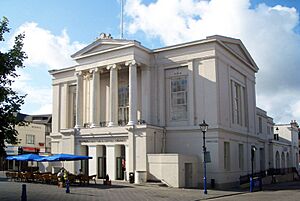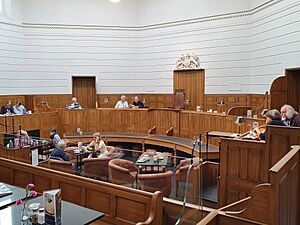St Albans Town Hall facts for kids
Quick facts for kids St Albans Town Hall |
|
|---|---|

St Albans Town Hall in 2008
|
|
| Location | St Peter's Street, St Albans |
| Built | 1826 |
| Architect | George Smith |
| Architectural style(s) | Neoclassical style |
|
Listed Building – Grade II*
|
|
| Official name: Court house (town hall) | |
| Designated | 8 May 1950 |
| Reference no. | 1296135 |
| Lua error in Module:Location_map at line 420: attempt to index field 'wikibase' (a nil value). | |
St Albans Town Hall is a historic building in St Albans, England. It was built in the 1800s and is also called the Old Town Hall or The Courthouse. Today, this special building is home to the St Albans Museum. It is also a Grade II* listed building, which means it's an important historical site.
Contents
History of St Albans Town Hall
The St Albans Town Hall was built to replace an older building called the Moot Hall. The Moot Hall was built in 1570 but became very old and worn out. People in St Albans discussed where to build the new town hall. Some wanted it in Romeland, while others preferred St Peter's Street.
They finally agreed to build the new town hall on St Peter's Street. This new building would serve two purposes. It would be a town hall for local government and a courtroom for legal cases. The famous architect George Smith designed the building. He used a style called neoclassical, which looks like ancient Greek and Roman buildings. The new town hall was finished in 1826.
The Town Hall as a Courtroom
For many years, the St Albans Town Hall was an important place for legal matters. St Albans had its own special court system called "quarter sessions." This was because of an old area known as the Liberty of St Albans.
In 1851, a big investigation happened at the town hall. It was about a scandal where people were accused of buying votes during an election. The investigation found that many voters had received money for their votes. Because of this, St Albans lost its right to have a representative in Parliament for a while. The area got its parliamentary representation back in 1885.
Later, in 1874, the county of Hertfordshire was divided into two legal areas. St Albans was in the western part. The town hall continued to host important court hearings. However, in 1972, a new law changed how courts worked in England. The old "quarter sessions" were replaced by "crown court" hearings.
The town hall stopped being a place for court cases in 1992. The crown court hearings moved to a new courthouse on Bricket Road.
The Town Hall and Local Government
Besides being a courtroom, the St Albans Town Hall was also the main office for the St Albans City Council. This was the local government that managed the city. The building also hosted meetings for the St Albans Rural District Council for many years.
In 1966, the St Albans City Council moved to a new building called the City Hall. This new City Hall was also on St Peter's Street. Then, in 1989, the council moved again to an even newer building called the Civic Centre.
After the council moved out, the town hall was empty for some time. But then, a big project began to turn it into a museum. After a lot of work and costing £7.75 million, the St Albans Museum moved into the old town hall. The museum officially opened its doors in June 2018.
Architecture of the Town Hall
The St Albans Town Hall has a grand and balanced design. The front of the building faces the Market Square. It has three main sections. The middle section has a raised platform on the ground floor with three windows. Above this, there are four tall columns with fancy tops, supporting a large decorative block and a triangular roof section.
Inside the building, there are two main rooms. One is a large assembly hall, which is also used as a ballroom for dances and events. The other is the courtroom, which has an interesting eight-sided shape and wooden panels on the walls.
See also


